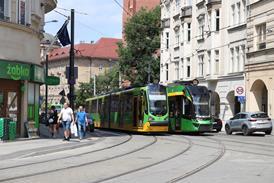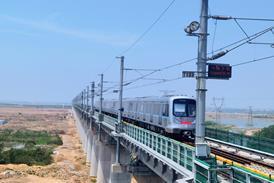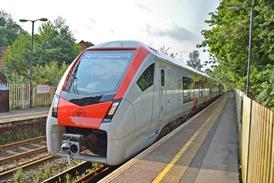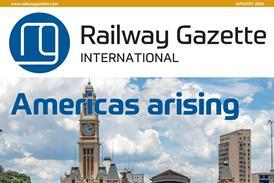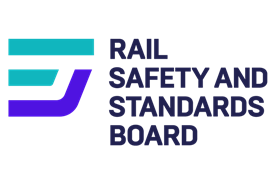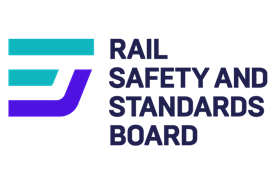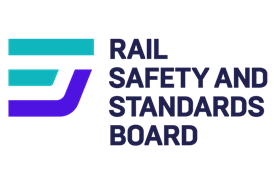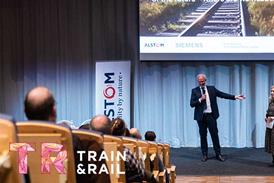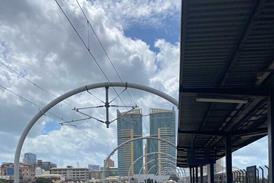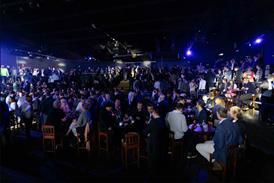INTRO: A fleet of 60 high performance 3 kV DC or 25 kV AC locomotives being built by GEC Alsthom for Belgian National Railways will replace units dating from the 1950s and 1960s. Another 20 locos are on order for Luxembourg National Railways
BYLINE: Harry Hondius MSc Eng
BY THE START of this month Belgian National Railways should have five Class 13 Tractis locomotives on test. A further 15 are to be delivered in 1999, and 40 more by the end of September 2001. Luxembourg National Railways will receive 15 identical machines this year and five during 1999.
The Tractis is a dual-system locomotive able to collect power at the standard Belgian overhead supply of 3 kV DC, or at 25 kV 50Hz on newly-electrified lines in Belgium, in Luxembourg and in France. There is limited capability to accept 1·5 kV DC at Dutch frontier stations.
The 60-strong Belgian fleet will replace a large number of locos built from 1954 onwards. Today SNCB operates 51 multi-system locos, of which 24 were delivered in 1985-86 with chopper control and can be considered as modern: 12 equipped to run at 1·5 or 3 kV DC, and 12 for 3 kV DC or 25 kV 50Hz. Another 325 units for 3 kV DC operation complete the SNCB fleet; only Classes 20, 21 and 27 totalling 145 units have choppers.
Apart from Classes 18 and 26, all locos were designed by SNCB in-house, making use of bogie technology developed by SLM of Switzerland. They were built or assembled by BN, now part of Bombardier Transportation, and with the exception of the six Alsthom-built Class 18 units, all have electrical equipment from ACEC.
CFL does not possess any 3 kV DC locomotives but it does have 19 centre-cab 25 kV locos built by MTE in 1958-59. These will all be replaced by the new units, which CFL has designated Class 30.
Contract
A joint order for the 80 locos was placed by the two railways after a European bidding contest. The contract was signed on December 22 1995 with GEC Alsthom’s Belgian subsidiary, ACEC Transport of Charleroi. Price per locomotive was BFr140·5m, but to this figure must be added spares at 5% of the purchase value. Prices from rival bidders Adtranz and Siemens were within 1% of the winning bid.
At the same time, SNCB ordered electrical equipment for 21 Type I11 driving trailer cars with the same cab layout as Tractis for push-pull working.
The first 10 Tractis locomotives will be completely fabricated and assembled by GEC Alsthom in Belfort; mechanical parts for the rest will be fabricated at Belfort (body) and Le Creusot (bogies). They will be assembled at Bombardier’s BN plant in Brugge.
Transformers will be delivered by Pauwels, the three-phase motors by GEC Alsthom, Ornans, and the rest of the electrical equipment by ACEC Transport which will install it at Brugge.
The units are designed to deliver full tractive effort under both power supplies, so they will be able to work freely across the SNCB-CFL frontiers at Gouvy and Rodange. To permit operation on SNCF routes they are fitted with the French KVB automatic train protection and crocodile automatic warning systems, as well as the standard Belgian and Luxembourg safety equipment.
Tractis will also be able to use the Rivage - Gouvy and Dinant - Athus routes when electrification is completed in 1999-2000. From 2003 they will haul inter-city trains at up to 200 km/h on high speed tracks between Leuven and Ans.
Tractis units have the ability to operate at 1·5 kV DC to permit cross-border working into Roosendaal and Maastricht stations on the Dutch border. The continuous rating is reduced to 2100 kW at the lower voltage.
Design of the bodies and bogies (Fig 1) is derived from SNCF’s Astride class. The all-steel welded body has air-conditioned cabs.
Traction and braking forces are transmitted between body and bogies by two low-level traction rods per bogie, one in each direction. These rods are connected to the lowest point of the bogie frame to minimise weight transfer between axles.
Flexicoil secondary springs are complemented by one horizontal and two vertical dampers. Yaw dampers are placed between the bogie frame and the body. The welded steel bogie frame rests on steel springs with vertical dampers on the axleboxes; the axles are guided by radius arms.
The three-phase asynchronous traction motor is connected to the gearbox, and the whole assembly is suspended from the bogie frame on three rubber springs. The axles are driven by Jacquemin hollow shafts with floating rings.
Each axle has four air-operated disc brakes acting on the wheels. Three disc brakes with spring-loaded actuators act as the parking brake. The capacity of mechanical braking is such that the loco is fully functional even if the dynamic brake cannot be used. All wheels are fitted with tread brakes, and wheel flange lubricators and sanders are provided. Anti-skid and anti-slip functions are applied individually to the axles.
Electrical equipment
There are two Faiveley pantographs, one for 25 kV and one for 3 kV. AC is taken to the oil-cooled transformer, which is slung under the locomotive frame, and DC (including 1·5 kV) directly to the 3 kV choppers. Transformer oil is cooled by the same air as that used for the brake resistors.
Each force-ventilated four-pole asynchronous traction motor circuit is independent (Fig 2). When operating under AC catenary, power is taken from a 1520V winding rated at 1375 kVA and fed to the motors via a pulse-width modulated GTO thyristor rectifier and an inverter, which uses the same type of thyristors as the rectifier.
Under 3 kV, a three-level chopper maintains the same 2·4 kV as the rectifier feeding the same inverter, thus giving the motors the same output under both systems. Switching from one power supply to the other is carried out by the driver; an automatic protection device prevents damage to equipment if the wrong selection is made.
Dynamic braking offers regenerative braking under 25 kV and 3 kV, but only rheostatic braking operates if the loco is taking power at 1·5 kV.
All electronic circuits are monitored by a central computer. The power electronics are of modular construction; heat is removed by sealed liquid coolant circuits which pass through air-cooled heat exchangers.
The auxiliary winding of the transformer produces 800 kVA for train heating when the ambient temperature is below 10°C and 600 kVA above that temperature. Two auxiliary inverters each produce three-phase 50Hz at 380V and 150 kVA as well as a 110V DC supply rated at 15 kW.
A Knorr SL120 compressor is fitted, and there are two 500 litre air reservoirs under the main frame. All auxiliary motors run off the 380V three-phase apart from that driving the auxiliary compressor.
A train bus permits multiple-unit operation and push-pull working.
SNCB and GEC Alsthom have gone to great lengths to develop a locomotive with low life-cycle costs and high availability. This has been achieved by duplicating key components such as inverters and providing central fault diagnosis that eases the task of maintenance staff. o
CAPTION: SNCB has begun trials with its first Class 13 Tractis locomotive
CAPTION: Fig 1. Design of mechanical parts is based on the French Astride locomotives
CAPTION: The Tractis cab design meets European interoperability requirements
CAPTION: Fig 2. Main traction circuits of the dual-voltage design feature independent power conversion for each motor
CAPTION: Fig 3. Maximum speed of Class 13 is 200 km/h when drawing power at 3 kV
TABLE: Technical data of Tractis: SNCB Class 13 and CFL Class 30
Axle arrangement Bo’Bo’
Length over buffers mm 19110
Bogie centres mm 10400
Width mm 3026
Weight tonnes 90
Bogie wheelbase mm 3000
Wheel diameter (new/used) mm 1160/1090
Starting tractive effort kN 288
Continuous power at wheelrim at 3 kV DC and 25 kV/50Hz kW 5000
Maximum speed km/h 200
Type of traction motor 4FXA4-559B
Gear ratio 1:3·96
Deux réseaux essaient les locomotives Tractis bicourant
Un parc de 60 machines à hautes performances, pouvant fonctionner sous 3 kV continu et 25 kV 50Hz, fourni par GEC Alsthom ACEC Transport pour les chemins de fer nationaux de Belgique, va remplacer des engins dont certains datent des années 1950 et 1960. Une autre série de 20 unités a été commandée par les chemins de fer luxembourgeois. Conçues pour circuler librement entre la Belgique et le Luxembourg, elles sont également équipées du KVB français, système de contr

